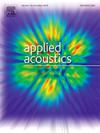High gain beamforming method in low-frequency band using virtual array migration
IF 3.4
2区 物理与天体物理
Q1 ACOUSTICS
引用次数: 0
Abstract
When measuring the low-frequency radiated noise of underwater low-noise targets, a conflict arises between the large-scale array’s ability to achieve low-frequency gain and the reduction of propagation loss at a fixed measurement distance. This paper presents a method for virtual array element migration, based on the measured phase modulation of array elements. By increasing the phase differences between adjacent elements and further enhancing the phase differences between steering vectors in different directions, the proposed method improves the suppression of undesired directional interference signals, thereby enabling high-gain measurements under limited aperture conditions. To mitigate the reduction in robustness associated with virtual array construction, a virtual array factor is introduced for analysis. The results demonstrate that when the virtual array factor is set to 1, the proposed method performs comparably to conventional beamforming. When the virtual array factor exceeds 1, it can effectively enhance the suppression of interference signals in the low-frequency range. The optimal value of this factor should be selected based on the signal-to-noise ratio of the data to ensure the robustness of the algorithm. Both simulation and lake test data demonstrate that the proposed algorithm significantly outperforms conventional methods in terms of its ability to reject interference in low-frequency radiated noise measurements.
求助全文
约1分钟内获得全文
求助全文
来源期刊

Applied Acoustics
物理-声学
CiteScore
7.40
自引率
11.80%
发文量
618
审稿时长
7.5 months
期刊介绍:
Since its launch in 1968, Applied Acoustics has been publishing high quality research papers providing state-of-the-art coverage of research findings for engineers and scientists involved in applications of acoustics in the widest sense.
Applied Acoustics looks not only at recent developments in the understanding of acoustics but also at ways of exploiting that understanding. The Journal aims to encourage the exchange of practical experience through publication and in so doing creates a fund of technological information that can be used for solving related problems. The presentation of information in graphical or tabular form is especially encouraged. If a report of a mathematical development is a necessary part of a paper it is important to ensure that it is there only as an integral part of a practical solution to a problem and is supported by data. Applied Acoustics encourages the exchange of practical experience in the following ways: • Complete Papers • Short Technical Notes • Review Articles; and thereby provides a wealth of technological information that can be used to solve related problems.
Manuscripts that address all fields of applications of acoustics ranging from medicine and NDT to the environment and buildings are welcome.
 求助内容:
求助内容: 应助结果提醒方式:
应助结果提醒方式:


